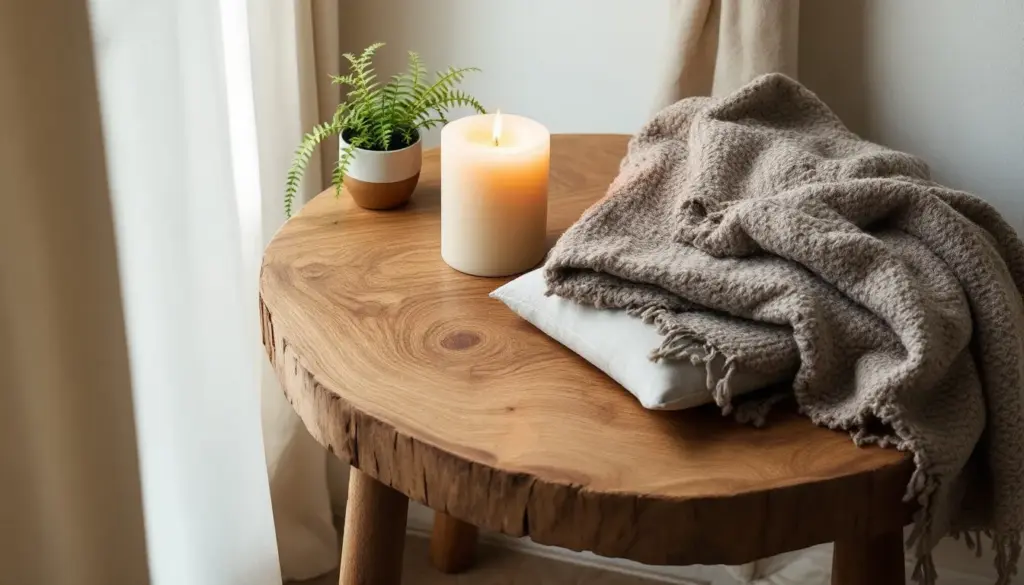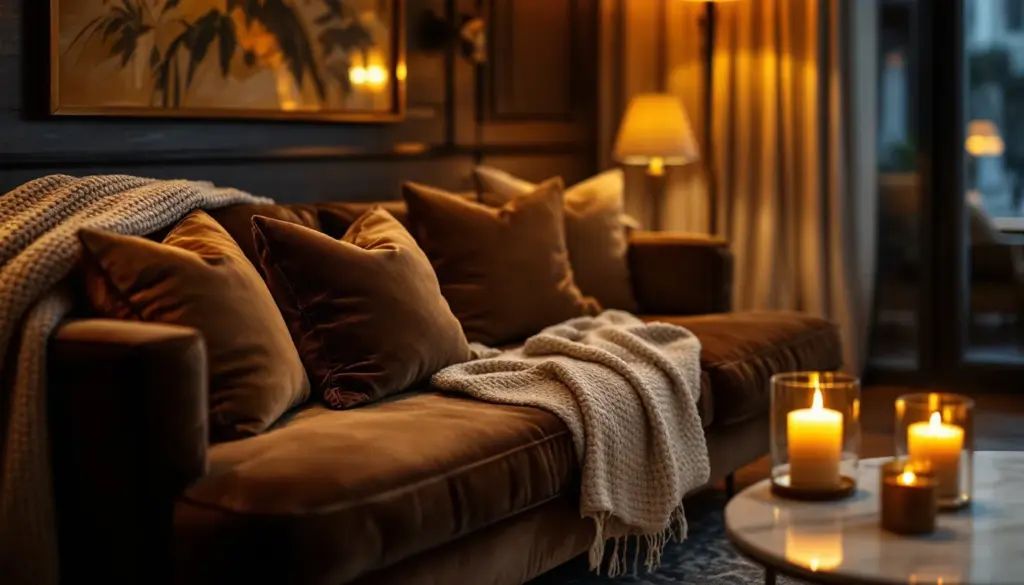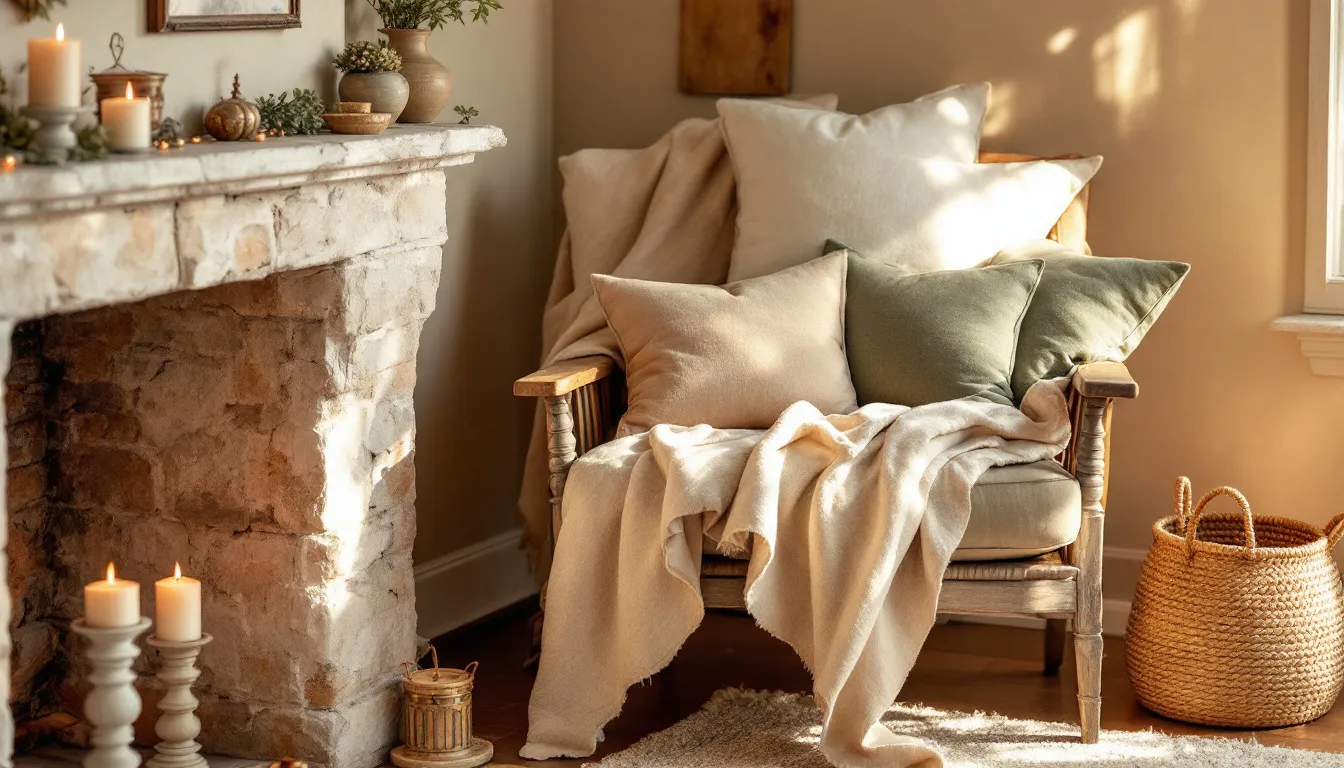The Danish concept of hygge has helped make Denmark’s people among the happiest on Earth. It’s all about creating comfort and coziness through life’s simple pleasures, from quality time with loved ones to thoughtfully decorated spaces that feel like a warm hug.
Your living room serves as the heart of family gatherings and friendly visits, making it the perfect spot to embrace hygge’s welcoming spirit. While this decorating approach has gained popularity in America since 2016, it’s much more than just another passing trend.
It’s about cultivating an authentic feeling of contentment and comfort that lasts throughout the year by transforming your space with meaningful details and personal touches.
What Is Hygge?
Hygge (pronounced “hoo-gah”) emerged from Danish culture in the 1930s as a lifestyle philosophy centered on creating contentment through simplicity. The concept emphasizes finding joy in life’s modest moments while cultivating an atmosphere of warmth.
Dating back to the 1950s, hygge gained prominence alongside other Scandinavian design principles focused on harmony with surroundings. The philosophy builds on three core elements: affordability, simplicity, functionality – combining them to foster a sense of wellbeing.
A hygge-inspired space transforms everyday experiences into meaningful moments through:
- Soft lighting from candles or dim lamps
- Natural materials like wooden furniture
- Plush textiles including blankets cushions
- Calm uncluttered arrangements
- Intimate gathering spots
- Indoor plants greenery
The essence of hygge extends beyond mere decorative choices.
In Danish homes, this approach creates sanctuaries for relaxation connection allowing occupants to fully embrace life’s simple pleasures without modern-day pressures.
It’s about crafting an environment where stress melts away as comfort takes hold.
The Core Elements of Hygge Design

Creating a hygge-inspired living room relies on carefully combining natural elements, soft lighting and comforting details. These core elements work together to establish a serene, welcoming atmosphere that promotes relaxation and contentment.
Natural Materials
Natural materials form the foundation of hygge design by connecting indoor spaces with organic elements. Wooden furniture pieces like coffee tables and bookcases introduce warmth through their rich grains and tactile surfaces.
Stone accents and living plants complete the organic ambiance, bringing the calming essence of nature indoors.
Textiles made from natural fibers – wool, linen, cashmere, mohair – add layers of comfort through throws, pillows and blankets.
Warm, Inviting Lighting
Lighting creates the cozy atmosphere essential to hygge design.
Natural daylight streams through windows, brightening the space during daytime hours. The layered approach to lighting allows for customized ambiance throughout the day.
Soft, warm-toned table lamps and floor lamps with dimmable settings provide adjustable illumination. Candles play a vital role, their flickering flames casting a gentle glow while scented varieties like vanilla and cinnamon enhance the sensory experience.
Neutral and Earthy Color Palettes
Earthy and neutral tones establish balance and serenity in hygge spaces. Shades of beige, brown, grey and muted green create a soothing backdrop that allows textural elements to shine.
The palette promotes tranquility while providing a versatile foundation for seasonal decor changes.
These calming colors appear through rugs, curtains and decorative pieces.
Thoughtful Details
Carefully selected details turn into a room into a hygge haven. Plush throws draped over chairs invite relaxation while handwoven rugs add visual interest and warmth underfoot.
Each element serves both aesthetic and comfort purposes, creating an environment that encourages mindful enjoyment of everyday moments.
Indoor plants – whether real or faux – infuse life into the space.
Fresh or dried flowers bring touches of nature and seasonal charm.
How Hygge Elevates Luxury Spaces
Hygge transforms ordinary living spaces into luxurious sanctuaries through intentional design choices centered on comfort and connection. The Danish philosophy brings warmth and sophistication to modern interiors while maintaining a relaxed atmosphere.
Focus on Comfort
Plush textiles create the foundation of hygge comfort in luxury spaces.
Natural materials like cotton, linen and wool add organic texture through upholstery and accent pieces.
Soft bouclé blankets, velvet pillows and thick knit throws invite tactile exploration.
Furniture selection prioritizes deep-seated sofas and oversized armchairs that encourage lingering. Reading nooks feature comfortable seating paired with warm lighting from table or floor lamps.
The lighting creates distinct zones for relaxation while maintaining an intimate ambiance.
A Space for Connection
Open layouts promote natural flow and engagement between different areas. Intimate seating arrangements feature chairs and sofas positioned at conversational angles.
These thoughtful groupings facilitate easy dialogue and meaningful interaction.
Strategic placement of communal spaces, like dining areas and gathering spots, draws people together.
The overall design supports both casual conversations and deeper connections.
Soft lighting from candles and lamps creates a welcoming atmosphere that encourages guests to linger.
Balance of Minimalism and Warmth
Clean lines and uncluttered spaces provide a serene foundation while preserving hygge’s cozy essence.
Rich textures through textiles, natural woods and woven elements add depth without overwhelming the minimalist backdrop. This creates visual interest while maintaining simplicity.
Careful editing prevents spaces from feeling stark or cold. Strategic layering of materials, from smooth surfaces to plush fabrics, adds dimension.
The result is an environment that feels both refined and inviting – the perfect balance of luxury and comfort.
Making Hygge Personal
Creating a hygge-inspired living room starts with personalizing the space to reflect individual style and emotional connections. Each element contributes to a warm atmosphere that celebrates meaningful moments and cherished memories.
Customization and Bespoke Design
Personal artifacts turn into a living room into a storytelling sanctuary. Family heirlooms displayed on mantels capture generational histories while travel souvenirs arranged on shelves spark conversations about adventures abroad.
Photos in vintage frames create intimate gallery walls that celebrate shared experiences.
Hand-crafted items infuse spaces with authenticity.
Artisanal pottery pieces showcase local craftsmanship while handwoven textiles add cultural depth. Custom furniture pieces adapted to specific spatial needs enhance both function and sentiment.
Layering Textures and Styles
Tactile elements create visual depth through thoughtful combinations. Chunky knit throws draped over smooth leather seating provide textural contrast while sheepskin rugs layered atop jute weaves add dimensional interest.
Natural wood grain pairs with polished metals to balance rustic and refined finishes.
Modern interpretations of classic Scandinavian design maintain hygge’s essence.
Clean-lined furniture features organic curves that soften minimalist forms. Matte ceramics sit alongside glossy glass pieces while rough-hewn wooden bowls complement sleek metal accents.
Create Intentional Moments
Designated areas invite mindful rituals and quiet reflection.
Coffee stations near fireplaces encourage morning contemplation while cozy window seats offer spaces for evening relaxation.
Reading nooks tucked into corners feature plush armchairs oriented toward natural light.
Strategic furniture arrangements facilitate intimate gatherings.
Task lighting from adjustable sconces creates ambiance for various activities from reading to game nights.
Clustered seating areas promote conversation while side tables provide surfaces for tea cups and novels.
Why Hygge Is the Future of High-End Home Design

Hygge’s influence on luxury home design continues to expand as homeowners embrace its blend of comfort and sophistication. This Danish concept transforms living spaces into sanctuaries that promote both physical comfort and emotional wellbeing.
A Response to Modern Stress
Hygge design offers a peaceful retreat from the digital overwhelm and constant connectivity of modern life. The intentional arrangement of furniture creates intimate conversation areas, while soft textures in furnishings invite relaxation and mindful moments.
Natural materials like wooden coffee tables and woven baskets ground the space in tactile comfort. Plush upholstery in neutral tones provides visual rest for overstimulated minds.
Strategic lighting through table lamps and dimmable fixtures allows adjustment throughout the day, supporting natural circadian rhythms. Reading nooks with deep-seated armchairs become personal refuges for decompressing.
Sustainability and Timelessness
The minimalist principles of hygge naturally align with sustainable design practices. Quality pieces crafted from durable materials like solid wood and natural stone develop character over time rather than requiring frequent replacement.
Classic silhouettes in furniture avoid trendy details that quickly date a space. The focus on functionality means each item serves a clear purpose, reducing unnecessary consumption.
Natural fiber textiles in wool, linen and cotton age gracefully while providing comfort. Handcrafted elements showcase artisanal techniques that stand the test of time through their authenticity and craftsmanship.
Connection to Nature
Hygge design creates seamless transitions between indoor and outdoor spaces through large windows, glass doors and nature-inspired materials. Strategic placement of indoor plants brings living elements into every room.
Natural light flows freely through sheer window treatments, while outdoor views become living artwork. Organic shapes in furniture and decor echo forms found in nature.
Stone hearths, wooden beams and woven textures incorporate raw materials that ground spaces in the natural world. Water features add soothing sounds while connecting to natural elements.
Where To Look For More Inspiring Hygge Designs
Creating a hygge-inspired living room isn’t about following strict rules or copying trendy designs. It’s about discovering what brings comfort and joy to your space while staying true to your personal style.
Today’s design world offers endless inspiration through social media platforms like Pinterest and Instagram where Danish influencers share authentic hygge spaces. Local Scandinavian furniture stores and design boutiques also showcase how to blend comfort with style.
Remember that hygge is more than just decor – it’s a feeling. The most beautiful hygge spaces are the ones that tell your story and make everyone feel truly at home.
So take these ideas and make them your own!

